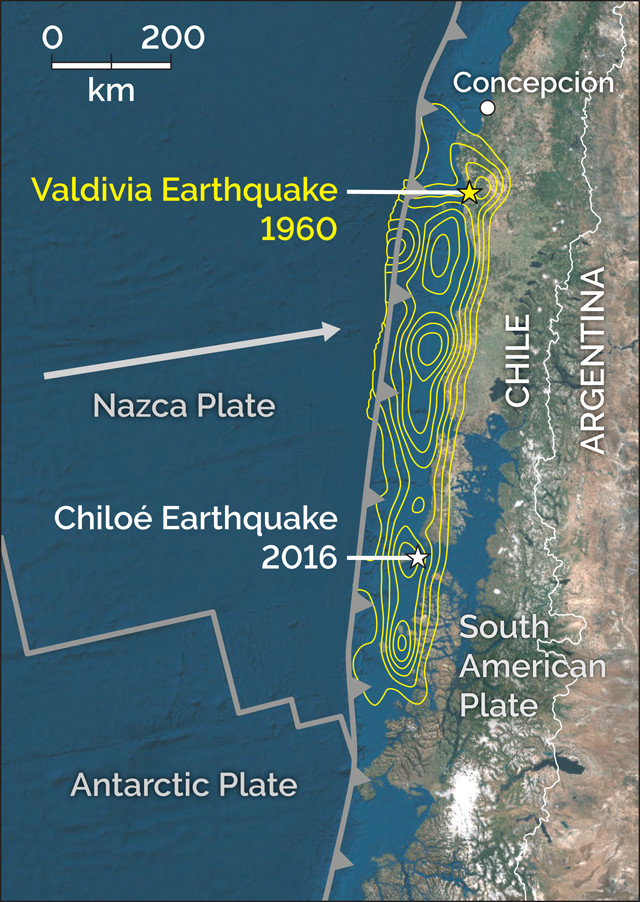
by Mary Caperton Morton Monday, March 19, 2018

The Nazca Plate, moving eastward at a rate of 6.6 centimeters per year, collides with, and dives beneath, the South American Plate off the Chilean coast, building strain. Credit: K. Cantner, AGI, after GEBCO world map 2014, gebco.net.
The largest earthquake in recorded history struck southern Chile on May 22, 1960. The magnitude-9.5 temblor was followed by a tsunami that, combined with the seismic shaking, killed 1,600 people and left more than 2 million homeless. New research suggests that, despite the staggering size of the event, the shaking didn’t dissipate all the strain accumulated at the time on the subduction fault between the Nazca and South American tectonic plates. The residual strain left on the fault may explain why a portion of this same section of fault ruptured again — 56 years later — on Dec. 25, 2016, in a magnitude-7.6 event.
Chile is susceptible to large earthquakes because just offshore, the Nazca Plate plows into, and dives under, the South American Plate at a relatively speedy rate of 6.6 centimeters per year. As the plates collide, strain builds up between them until it is released during earthquakes. The 1960 quake ruptured an area 850 kilometers long and 130 kilometers wide along the Chilean continental margin, resulting in more than 30 meters of slip and dramatically redrawing sections of the Chilean coastline.
Historical and paleoseismic records show that large earthquakes have rocked this region repeatedly — in 1575, 1737, 1837 and 1960. Quakes over the last two millennia suggest a recurrence interval of about 285 years. “Historical records in Chile are quite good, and tsunami records of large quakes date back to the 15th century, providing one of the longer pre-instrumental earthquake records in the world,” says Dietrich Lange, a seismologist at the GEOMAR Helmholtz Center for Ocean Research in Germany, and lead author of the new study published in Geophysical Journal International.
The 2016 quake broke a much smaller, 30-square-kilometer section of the same fault that ruptured in 1960, most likely a stubborn segment that didn’t break in the earlier event. Given how fast the Nazca Plate is plowing into the South American Plate, Lange’s team calculated how much strain would have built up — if the 1960 quake had released all of the strain — and how much slip could be expected in the next quake. The theoretical slip of the 2016 event was about 3.4 meters. But seismic data and GPS surveys conducted after the earthquake indicate that the fault actually slipped about 4.2 meters. The nearly one meter of extra slip can be chalked up to residual strain left over after the 1960 event, Lange says. “Some of the strain was older than the last earthquake in the same region,” he says. “It had to have been accumulating for more than 56 years.”
Residual strain left over after a large earthquake has also recently been observed in Ecuador, after the magnitude-7.8 Pedernales quake in 2016 broke a smaller section of the 500-kilometer-long segment of the Ecuadorian megathrust that ruptured in 1906 in a massive magnitude-8.8 event. “Large earthquakes are usually assumed to release all of the strain accumulated since the previous event, implying a reduced seismic hazard after them. However, long records of seismic history at several subduction zones suggest supercycle behavior, where centuries-long accumulated strain is released through clustered large earthquakes, resulting in an extended period of enhanced seismic hazard,” wrote Jean-Mathieu Nocquet of the University of Côte d’Azur in France and colleagues in a 2016 study in Nature Geoscience.
These findings have implications for earthquake hazard assessments, which often only account for stresses accumulated over a single earthquake cycle, and not residual strain left over from multiple cycles, says Gavin Hayes, a geophysicist with the U.S. Geological Survey’s Geologic Hazards Science Center in Golden, Colo., who was not involved in the new study. “To better understand repeat times of big events and what they mean for the earthquake cycle, we need to study strain accumulation and release cycles along subduction zones.”
Such work will require improving Chile’s seismic and geodetic monitoring networks, Hayes says. “We need to start moving into Chile’s offshore environment and install more seafloor instrumentation. Hopefully we’ll see more of that in the next decade.”
© 2008-2021. All rights reserved. Any copying, redistribution or retransmission of any of the contents of this service without the expressed written permission of the American Geosciences Institute is expressly prohibited. Click here for all copyright requests.